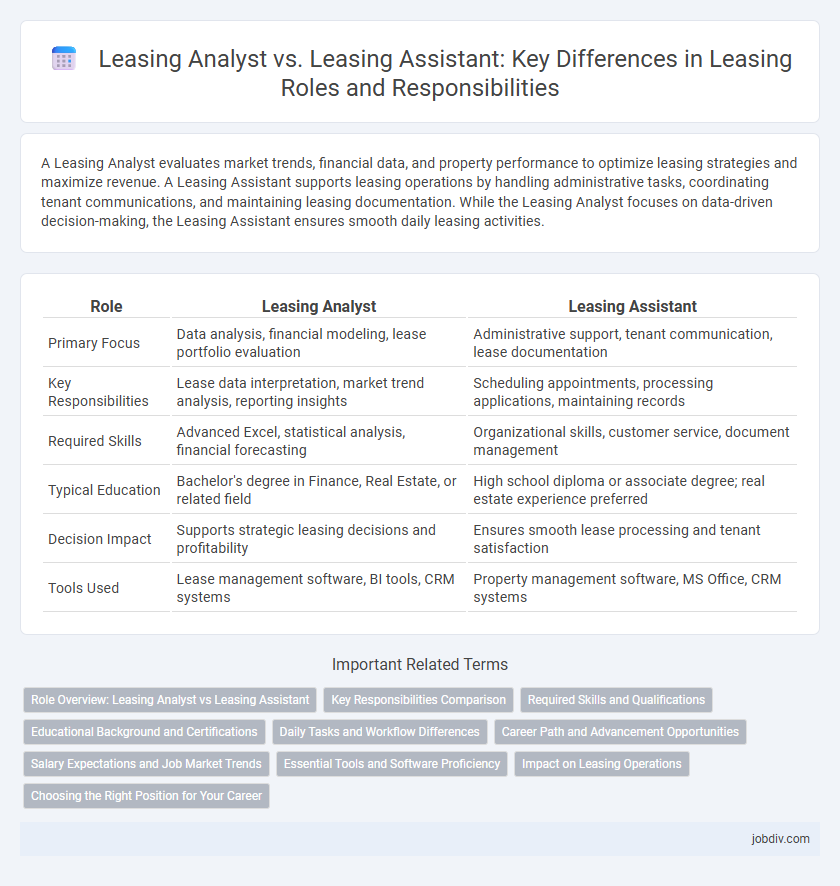A Leasing Analyst evaluates market trends, financial data, and property performance to optimize leasing strategies and maximize revenue. A Leasing Assistant supports leasing operations by handling administrative tasks, coordinating tenant communications, and maintaining leasing documentation. While the Leasing Analyst focuses on data-driven decision-making, the Leasing Assistant ensures smooth daily leasing activities.
Table of Comparison
| Role | Leasing Analyst | Leasing Assistant |
|---|---|---|
| Primary Focus | Data analysis, financial modeling, lease portfolio evaluation | Administrative support, tenant communication, lease documentation |
| Key Responsibilities | Lease data interpretation, market trend analysis, reporting insights | Scheduling appointments, processing applications, maintaining records |
| Required Skills | Advanced Excel, statistical analysis, financial forecasting | Organizational skills, customer service, document management |
| Typical Education | Bachelor's degree in Finance, Real Estate, or related field | High school diploma or associate degree; real estate experience preferred |
| Decision Impact | Supports strategic leasing decisions and profitability | Ensures smooth lease processing and tenant satisfaction |
| Tools Used | Lease management software, BI tools, CRM systems | Property management software, MS Office, CRM systems |
Role Overview: Leasing Analyst vs Leasing Assistant
A Leasing Analyst evaluates market trends, financial data, and lease terms to optimize property rental strategies and maximize ROI. A Leasing Assistant supports leasing operations through administrative tasks, client communication, and coordinating property viewings to facilitate smooth tenant acquisition. While the Leasing Analyst focuses on data-driven decision-making and strategic planning, the Leasing Assistant ensures operational efficiency and customer service in leasing processes.
Key Responsibilities Comparison
Leasing Analysts focus on financial data analysis, market research, and lease agreement evaluation to inform strategic leasing decisions, while Leasing Assistants handle administrative tasks such as processing applications, scheduling property showings, and managing tenant communications. Leasing Analysts often prepare detailed reports and forecasts to optimize leasing performance, whereas Leasing Assistants support day-to-day operations and customer service. Both roles contribute to effective leasing management but differ in their emphasis on analytical versus operational responsibilities.
Required Skills and Qualifications
Leasing Analysts require strong analytical skills, proficiency in financial modeling, and expertise in market research to evaluate lease agreements effectively. Leasing Assistants need excellent organizational abilities, customer service skills, and familiarity with property management software to support daily leasing operations efficiently. Both positions demand attention to detail, communication skills, and a basic understanding of lease terms and compliance regulations.
Educational Background and Certifications
Leasing Analysts typically hold a bachelor's degree in finance, real estate, or business administration, with relevant certifications such as Certified Leasing Specialist (CLS) or Real Estate License enhancing their expertise. Leasing Assistants often possess an associate degree or diploma in related fields and may pursue entry-level certifications like Certified Leasing and Sales Professional (CLSP). Advanced certifications and formal education distinguish Analysts by equipping them with deeper analytical skills for market assessments and lease negotiations, while Assistants support operations with foundational knowledge.
Daily Tasks and Workflow Differences
Leasing Analysts focus on evaluating and interpreting leasing data, preparing detailed reports, and developing financial models to support lease decisions, while Leasing Assistants handle administrative duties such as processing lease applications, scheduling property tours, and maintaining tenant records. Analysts typically engage with market trend analysis and lease portfolio performance, ensuring strategic alignment with business goals, whereas Assistants facilitate communication between tenants and leasing agents to streamline daily operations. The workflow of Analysts is data-driven and strategic, relying on analytical software, whereas Assistants follow a routine-centered approach emphasizing organizational tasks and customer service.
Career Path and Advancement Opportunities
Leasing Analysts typically have a more analytical role, focusing on market trends, financial data, and lease performance to support strategic decision-making, which positions them for advancement into senior analytical or management roles within real estate finance. Leasing Assistants generally handle administrative tasks, tenant communications, and lease documentation, serving as an entry point to higher leasing positions such as Leasing Coordinator or Leasing Manager through gaining operational experience. Career progression for Leasing Analysts often involves specialization in financial analysis or portfolio management, while Leasing Assistants build foundational leasing knowledge leading to broader property management or leasing leadership opportunities.
Salary Expectations and Job Market Trends
Leasing Analysts typically command higher salaries, averaging $60,000 to $80,000 annually, due to their expertise in financial analysis, market research, and portfolio management. Leasing Assistants generally earn between $35,000 and $50,000, supporting leasing operations through administrative duties and client coordination. Job market trends show increasing demand for Leasing Analysts as real estate companies seek data-driven decision-making, while Leasing Assistants remain essential for operational efficiency in growing leasing departments.
Essential Tools and Software Proficiency
Leasing Analysts primarily utilize advanced data analytics software, such as Excel with complex formulas, SQL databases, and leasing-specific platforms like Yardi and MRI to evaluate market trends and optimize lease portfolios. Leasing Assistants focus on customer relationship management (CRM) tools, basic Microsoft Office applications, and property management systems for scheduling, documentation, and tenant communications. Proficiency in these essential tools directly impacts the efficiency and accuracy of leasing operations and decision-making processes.
Impact on Leasing Operations
Leasing Analysts drive strategic decision-making by evaluating market trends, financial data, and tenant behaviors to optimize rental income and portfolio performance. Leasing Assistants support day-to-day operations by managing tenant communications, processing applications, and coordinating lease documentation, ensuring smooth workflow and tenant satisfaction. The combined efforts of both roles enhance leasing operations through data-driven insights and efficient administrative support.
Choosing the Right Position for Your Career
A Leasing Analyst conducts in-depth market research and financial analysis to optimize leasing strategies, making it ideal for professionals seeking data-driven decision-making roles. A Leasing Assistant handles administrative tasks and client communications, suited for those aiming to build foundational leasing experience and interpersonal skills. Choose the position aligning with your career goals: analytical expertise or client-focused support.
Leasing Analyst vs Leasing Assistant Infographic

 jobdiv.com
jobdiv.com